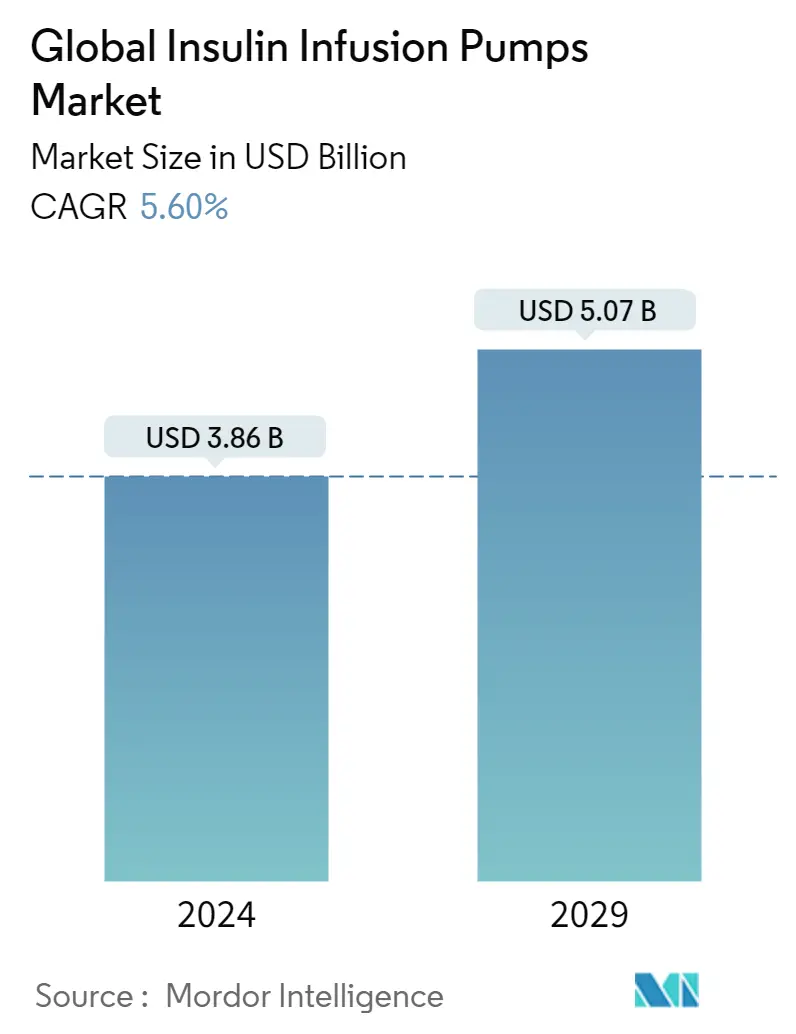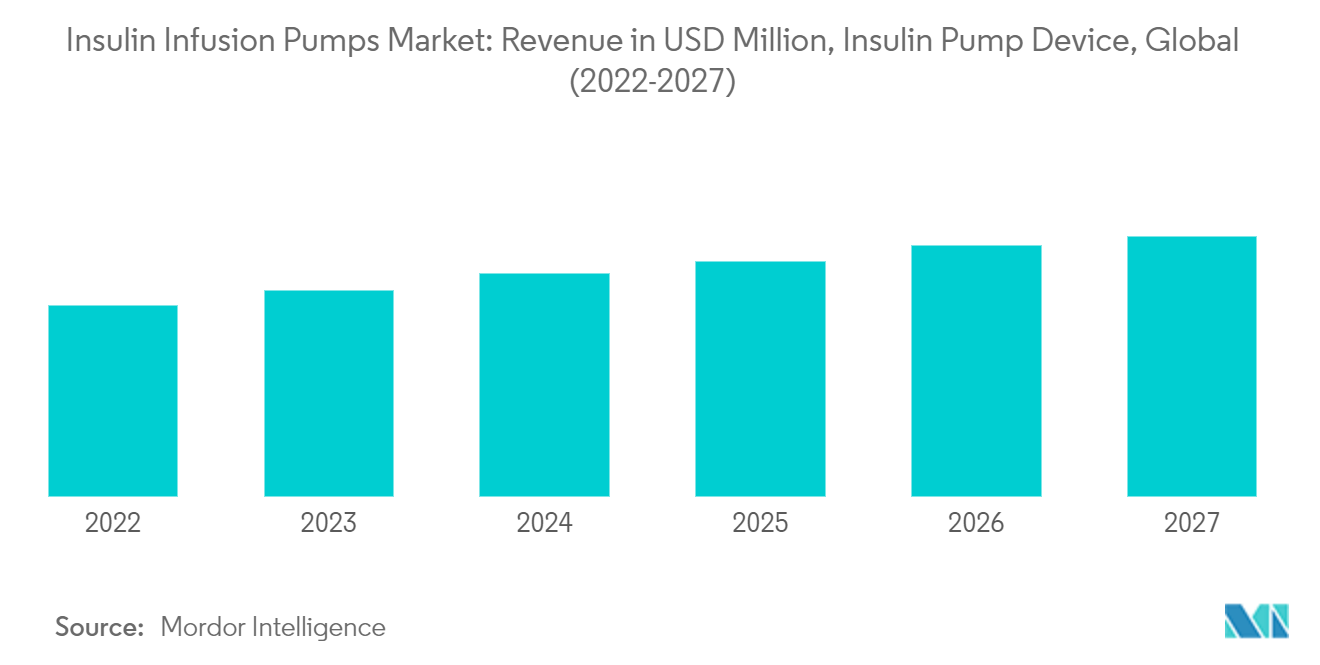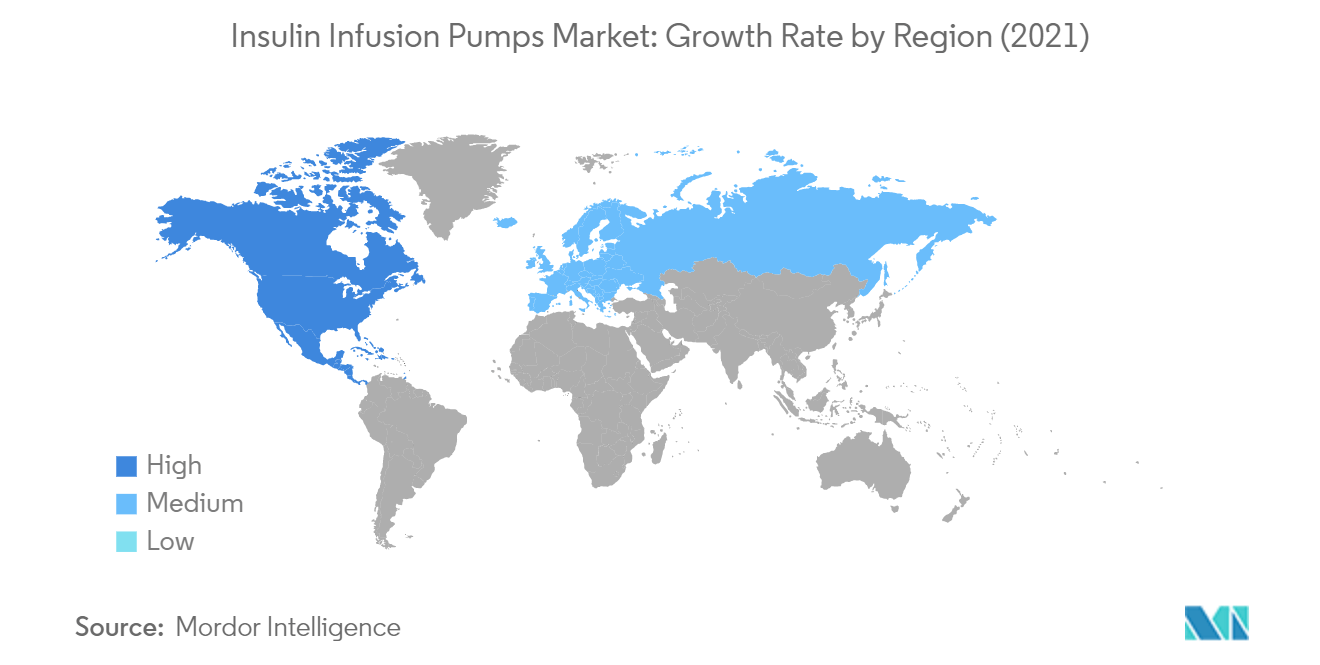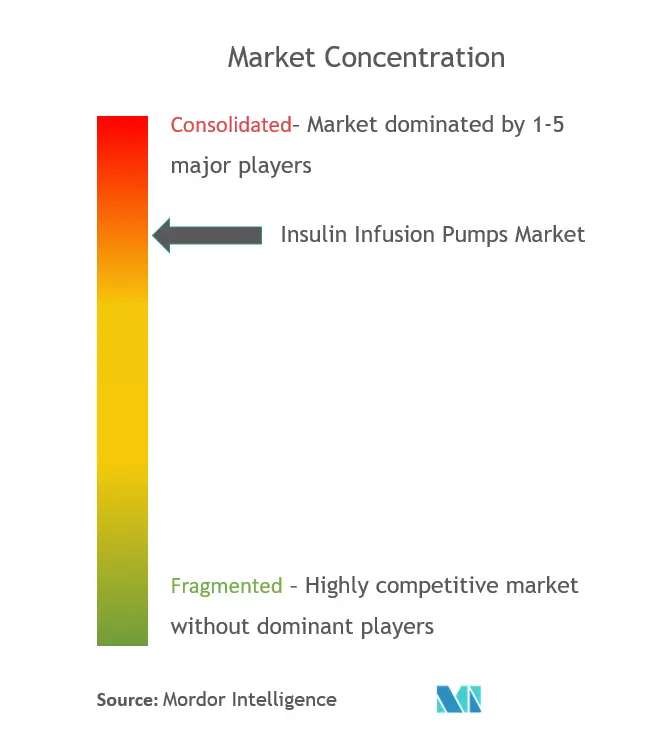Insulin Infusion Pumps Market Size

| Study Period | 2019 - 2029 |
| Market Size (2024) | USD 3.86 Billion |
| Market Size (2029) | USD 5.07 Billion |
| CAGR (2024 - 2029) | 5.60 % |
| Fastest Growing Market | North America |
| Largest Market | North America |
Major Players
*Disclaimer: Major Players sorted in no particular order |
Insulin Infusion Pumps Market Analysis
The Global Insulin Infusion Pumps Market size is estimated at USD 3.86 billion in 2024, and is expected to reach USD 5.07 billion by 2029, growing at a CAGR of 5.60% during the forecast period (2024-2029).
The market is estimated to reach USD 4.5 billion by 2027.
The COVID-19 pandemic positively impacted the Insulin Infusion Pumps Market. The SARS-CoV-2, which causes COVID-19, has resulted in over 100 million cases of infection and more than 2 million deaths globally as of February 2021. Diabetes and uncontrolled hyperglycemia are risk factors for poor outcomes in patients with COVID-19, including an increased risk of severe illness or death. Type-1 diabetes patients are impacted more during COVID-19. People with diabetes have a weaker immune system, the COVID-19 complication aggravates the condition, and the immune system gets weaker very fast. People with diabetes have more chances of getting into serious complications than normal people. The manufacturers of Insulin Infusion Pumps have taken care during COVID-19 to deliver insulin delivery devices to diabetes patients with the help of local governments.
An insulin infusion pump works as an alternative to the traditional system of daily injections or an insulin pen. Insulin infusion pumps reduce the large swings in blood glucose level, lessen pain, and deliver more accurately than injections. The scheduling of meal timings is not required when using pumps. This makes infusion pumps more user-friendly for patients. Insulin therapy is also known as continuous subcutaneous insulin infusion (CSII). It is an efficient and flexible method of insulin delivery. The insulin pump has evolved and is more reliable than it was previously. CSII technology has witnessed numerous technological advancements, like the integration of continuous glucose monitoring with the pump. Now, insulin pumps can control the algorithm automatically delivering the insulin after analyzing the blood glucose reading.
According to International Diabetes Federation (IDF), the adult diabetes population in 2021 was approximately 537 million, which will increase by 643 million in 2030. Approximately 10% of the total diabetes population has Type-1 diabetes, and approximately out of this 10% of people, only 80-90% use insulin delivery devices, but the usage of insulin is rising from time to time; even Type-2 diabetes patients started using the insulin delivery devices during COVID-19.
Technological advancements in insulin delivery devices have increased over time for safer and more accurate insulin administration. In 2021, Medtronic launched an Extended infusion set that leverages advanced materials that help reduce insulin preservative loss and maintains insulin flow and stability. The set is compatible with all MiniMed™ 600 and 700 series insulin pumps. The new tubing connector improves insulin's physical and chemical stability and reliability of infusion site performance and reduces the risk of infusion set occlusion. In addition to the new infusion set, the Medtronic Extended reservoir is also tested and approved to keep insulin stable and safely used for up to 7 days.
Therefore, owing to the aforementioned factors, the studied market is anticipated to witness growth over the analysis period.
Insulin Infusion Pumps Market Trends
This section covers the major market trends shaping the Insulin Infusion Pumps Market according to our research experts:
Insulin Pump is Expected to Witness Growth Over the Forecast Period
An insulin pump is a device that delivers insulin continuously or whenever required automatically. The pump mimics the human pancreas. The insulin infusion pump works as an alternative to the traditional system of daily injections or an insulin pen.
Insulin pump held a major market share in the insulin delivery devices market in 2021 and is expected to grow with a CAGR greater than 6.3% in the market during the forecast period because of the increasing technological advancement and preference over other traditional methods due to continuous insulin administration.
Insulin pump therapy is a well-established insulin administration method for type 1 diabetes (T1DM). Pumps are a validated, time-tested therapeutic option in T1DM at all ages, enabling near-physiological insulin delivery in situations where the pancreas does not produce insulin. There are even pump models with remote controls enabling parents of young children to either suspend or bolus insulin from a distance when the child is playing or eating. The insulin infusion pumps reduce the large swings in blood glucose level, induce less pain, and deliver more accurately when compared to injections. These advantages of insulin pumps over the traditional delivery system are expected to boost the market.
Continuous subcutaneous insulin infusion (CSII or insulin pumps) and continuous glucose monitoring systems (CGMs) have improved patient care and quality of life and are widely used in the ambulatory setting. Increasingly, this technology is also being used in the hospital setting.
Owing to the rising rate of obesity, growing genetic factors for type-2 diabetes, and the increasing number of Type-1 diabetes patients, it is likely that the insulin infusion pumps market will continue to grow.

North America is Expected to Dominate the Insulin Infusion Pump Market
North America holds the largest market share in the insulin pumps market and is also expected to register the highest CAGR of 6.9% during the forecast period.
North America is expected to dominate the market owing to factors such as the easy availability of insulin delivery devices, high awareness among consumers, and reimbursement policies.
The rapidly increasing incidence and prevalence of diabetic patients and healthcare expenditure in the United States indicates the increasing usage of diabetes care products. In the United States, according to the Academy of Managed Care Pharmacy, insulin pumps cost between USD 4,500 and USD 6,500 for individuals without insurance. The price varies depending upon the pump's features, brand, and size. For example, the Accu-Chek Spirit Insulin Pump costs about USD 4,600 and includes a few features, such as software that allows readings to be downloaded to a personal digital assistant (PDA). The Minimed Paradigm 522 is more expensive, retailing at about USD 5,200, but includes more features, like continuous glucose monitoring. Some insurance plans will cover the cost of the pump. Patients with insurance can expect typical copay and coinsurance rates ranging from USD 5 to half of the pump's total cost. Despite prices, diabetes patients in the United States use insulin delivery devices more often. Although the pump and its supplies (tubing, insulin cartridges, and infusion sets) continue to be expensive, insurance coverage has improved considerably over the years.
Therefore, owing to the aforesaid factors, the growth of the studied market is anticipated in the North America Region.

Insulin Infusion Pumps Industry Overview
The insulin infusion pumps market is consolidated due to the presence of only a few major companies operating globally and regionally. The competitive landscape includes an analysis of a few international and local companies that hold the market shares and are well known, including Medtronic PLC, Insulet Corporation, Ypsomed, Ascensia Diabetes Care, and Tandem Diabetes Care, among others.
Insulin Infusion Pumps Market Leaders
-
Medtronic PLC
-
Insulet Corporation
-
Tandem Diabetes Care
-
Ypsomed
-
Ascensia Diabetes Care
*Disclaimer: Major Players sorted in no particular order

Insulin Infusion Pumps Market News
- In April 2022, CamDiab and Ypsomed announced the partnership to develop and commercialize an integrated automated insulin delivery (AID) system to help lessen the burden of round-the-clock diabetes management for people with diabetes in European countries. The new integrated AID system is designed to connect Abbott's FreeStyle Libre® 3 sensor, the world's smallest and most accurate continuous glucose monitoring sensor with readings every minute, to CamDiab's CamAPS FX mobile app, which connects with Ypsomed's mylife™ YpsoPump® - creating a smart, automated process to deliver insulin based on real-time glucose data. The connected, smart wearable solution is designed to continuously monitor a person's glucose levels and automatically adjust and deliver the right amount of insulin at the right time, removing the guesswork of insulin dosing.
- In April 2021, Medtronic introduced the Medtronic Extended infusion set in select European countries - the first and only infusion set that can be worn for up to 7 days. This innovation doubles the time an infusion set can be worn so users can safely stay on insulin pump therapy with fewer interruptions and insertions while introducing enhanced convenience and comfort to their diabetes management routine. The set is compatible with all MiniMed™ 600 and 700 series insulin pumps.
Insulin Infusion Pumps Market Report - Table of Contents
1. INTRODUCTION
- 1.1 Study Assumptions
- 1.2 Scope of the Study
2. RESEARCH METHODOLOGY
3. EXECUTIVE SUMMARY
4. MARKET DYNAMICS
- 4.1 Market Overview
- 4.2 Drivers
- 4.3 Restraints
-
4.4 Porter's Five Forces Analysis
- 4.4.1 Bargaining Power of Suppliers
- 4.4.2 Bargaining Power of Consumers
- 4.4.3 Threat of New Entrants
- 4.4.4 Threat of Substitute Products and Services
- 4.4.5 Intensity of Competitive Rivalry
5. MARKET SEGMENTATION
-
5.1 Component (Value and Volume, 2016-2027)
- 5.1.1 Insulin Pumps
- 5.1.2 Infusion Sets
- 5.1.3 Reservoirs
-
5.2 Geography
- 5.2.1 North America
- 5.2.1.1 United States (Value and Volume 2016-2027)
- 5.2.1.1.1 By Insulin Pump Devices
- 5.2.1.1.2 By Infusion Sets
- 5.2.1.1.3 By Reservoirs
- 5.2.1.2 Canada (Value and Volume, 2016-2027)
- 5.2.1.2.1 By Insulin Pump Devices
- 5.2.1.2.2 By Infusion Sets
- 5.2.1.2.3 By Reservoirs
- 5.2.1.3 Rest of North America (Value and Volume, 2016-2027)
- 5.2.1.3.1 By Insulin Pump Devices
- 5.2.1.3.2 By Infusion Sets
- 5.2.1.3.3 By Reservoirs
- 5.2.2 Asia-Pacific
- 5.2.2.1 Japan (Value and Volume, 2016-2027)
- 5.2.2.1.1 By Insulin Pump Devices
- 5.2.2.1.2 By Infusion Sets
- 5.2.2.1.3 By Reservoirs
- 5.2.2.2 South Korea (Value and Volume 2016-2027)
- 5.2.2.2.1 By Insulin Pump Devices
- 5.2.2.2.2 By Infusion Sets
- 5.2.2.2.3 By Reservoirs
- 5.2.2.3 China (Value and Volume, 2016-2027)
- 5.2.2.3.1 By Insulin Pump Devices
- 5.2.2.3.2 By Infusion Sets
- 5.2.2.3.3 By Reservoirs
- 5.2.2.4 India (Value and Volume, 2016-2027)
- 5.2.2.4.1 By Insulin Pump Devices
- 5.2.2.4.2 By Infusion Sets
- 5.2.2.4.3 By Reservoirs
- 5.2.2.5 Australia (Value and Volume, 2016-2027)
- 5.2.2.5.1 By Insulin Pump Devices
- 5.2.2.5.2 By Infusion Sets
- 5.2.2.5.3 By Reservoirs
- 5.2.2.6 Vietnam (Value and Volume, 2016-2027)
- 5.2.2.6.1 By Insulin Pump Devices
- 5.2.2.6.2 By Infusion Sets
- 5.2.2.6.3 By Reservoirs
- 5.2.2.7 Malaysia (Value and Volume, 2016-2027)
- 5.2.2.7.1 By Insulin Pump Devices
- 5.2.2.7.2 By Infusion Sets
- 5.2.2.7.3 By Reservoirs
- 5.2.2.8 Indonesia (Value and Volume, 2016-2027)
- 5.2.2.8.1 By Insulin Pump Devices
- 5.2.2.8.2 By Infusion Sets
- 5.2.2.8.3 By Reservoirs
- 5.2.2.9 Philippines (Value and Volume, 2016-2027)
- 5.2.2.9.1 By Insulin Pump Devices
- 5.2.2.9.2 By Infusion Sets
- 5.2.2.9.3 By Reservoirs
- 5.2.2.10 Thailand (Value and Volume, 2016-2027)
- 5.2.2.10.1 By Insulin Pump Devices
- 5.2.2.10.2 By Infusion Sets
- 5.2.2.10.3 By Reservoirs
- 5.2.2.11 Rest of Asia - Pacific (Value and Volume, 2016-2027)
- 5.2.2.11.1 By Insulin Pump Devices
- 5.2.2.11.2 By Infusion Sets
- 5.2.2.11.3 By Reservoirs
- 5.2.3 Europe
- 5.2.3.1 United Kingdom (Value and Volume, 2016-2027)
- 5.2.3.1.1 By Insulin Pump Devices
- 5.2.3.1.2 By Infusion Sets
- 5.2.3.1.3 By Reservoirs
- 5.2.3.2 France (Value and Volume, 2016-2027)
- 5.2.3.2.1 By Insulin Pump Devices
- 5.2.3.2.2 By Infusion Sets
- 5.2.3.2.3 By Reservoirs
- 5.2.3.3 Germany (Value and Volume, 2016-2027)
- 5.2.3.3.1 By Insulin Pump Devices
- 5.2.3.3.2 By Infusion Sets
- 5.2.3.3.3 By Reservoirs
- 5.2.3.4 Italy (Value and Volume, 2016-2027)
- 5.2.3.4.1 By Insulin Pump Devices
- 5.2.3.4.2 By Infusion Sets
- 5.2.3.4.3 By Reservoirs
- 5.2.3.5 Spain (Value and Volume, 2016-2027)
- 5.2.3.5.1 By Insulin Pump Devices
- 5.2.3.5.2 By Infusion Sets
- 5.2.3.5.3 By Reservoirs
- 5.2.3.6 Russia (Value and Volume, 2016-2027)
- 5.2.3.6.1 By Insulin Pump Devices
- 5.2.3.6.2 By Infusion Sets
- 5.2.3.6.3 By Reservoirs
- 5.2.3.7 Rest of Europe (Value and Volume, 2016-2027)
- 5.2.3.7.1 By Insulin Pump Devices
- 5.2.3.7.2 By Infusion Sets
- 5.2.3.7.3 By Reservoirs
- 5.2.4 Latin America
- 5.2.4.1 Mexico (Value and Volume, 2016-2027)
- 5.2.4.1.1 By Insulin Pump Devices
- 5.2.4.1.2 By Infusion Sets
- 5.2.4.1.3 By Reservoirs
- 5.2.4.2 Brazil (Value and Volume, 2016-2027)
- 5.2.4.2.1 By Insulin Pump Devices
- 5.2.4.2.2 By Infusion Sets
- 5.2.4.2.3 By Reservoirs
- 5.2.4.3 Rest of Latin America (Value and Volume, 2016-2027)
- 5.2.4.3.1 By Insulin Pump Devices
- 5.2.4.3.2 By Infusion Sets
- 5.2.4.3.3 By Reservoirs
- 5.2.5 Middle-East and Africa
- 5.2.5.1 Saudi Arabia (Value and Volume, 2016-2027)
- 5.2.5.1.1 By Insulin Pump Devices
- 5.2.5.1.2 By Infusion Sets
- 5.2.5.1.3 By Reservoirs
- 5.2.5.2 Iran (Value and Volume, 2016-2027)
- 5.2.5.2.1 By Insulin Pump Devices
- 5.2.5.2.2 By Infusion Sets
- 5.2.5.2.3 By Reservoirs
- 5.2.5.3 Egypt (Value and Volume, 2016-2027)
- 5.2.5.3.1 By Insulin Pump Devices
- 5.2.5.3.2 By Infusion Sets
- 5.2.5.3.3 By Reservoirs
- 5.2.5.4 Oman (Value and Volume, 2016-2027)
- 5.2.5.4.1 By Insulin Pump Devices
- 5.2.5.4.2 By Infusion Sets
- 5.2.5.4.3 By Reservoirs
- 5.2.5.5 South Africa (Value and Volume, 2016-2027)
- 5.2.5.5.1 By Insulin Pump Devices
- 5.2.5.5.2 By Infusion Sets
- 5.2.5.5.3 By Reservoirs
- 5.2.5.6 Rest of Middle-East and Africa (Value and Volume, 2016-2027)
- 5.2.5.6.1 By Insulin Pump Devices
- 5.2.5.6.2 By Infusion Sets
- 5.2.5.6.3 By Reservoirs
6. MARKET INDICATORS
- 6.1 Type-1 Diabetes Population (2016-2027)
- 6.2 Type-2 Diabetes Population (2016-2027)
7. COMPETITIVE LANDSCAPE
-
7.1 COMPANY PROFILES
- 7.1.1 Medtronic
- 7.1.2 Insulet
- 7.1.3 Ascensia
- 7.1.4 Tandem
- 7.1.5 Ypsomed
- *List Not Exhaustive
-
7.2 COMPANY SHARE ANALYSIS
- 7.2.1 Insulet
- 7.2.2 Medtronic
- 7.2.3 Others
8. MARKET OPPORTUNITIES AND FUTURE TRENDS
** Subject To AvailablityInsulin Infusion Pumps Industry Segmentation
An insulin pump is used to deliver insulin to achieve proper blood sugar control and minimize hypoglycemia's effects. The pump is composed of a pump reservoir similar to an insulin cartridge, a battery-operated pump, and a computer chip that allows the user to control the exact amount of insulin being delivered. The pump is attached to a thin plastic tube (an infusion set) with a soft cannula (or needle) at the end through which insulin passes. The insulin infusion pumps market is segmented by component (pump device, infusion set, and reservoir) and geography (North America, Europe, Asia-Pacific, Middle-East and Africa, and Latin America). The report offers the value (in USD million) for the above segments.
| Component (Value and Volume, 2016-2027) | Insulin Pumps | ||
| Infusion Sets | |||
| Reservoirs | |||
| Geography | North America | United States (Value and Volume 2016-2027) | By Insulin Pump Devices |
| By Infusion Sets | |||
| By Reservoirs | |||
| Geography | North America | Canada (Value and Volume, 2016-2027) | By Insulin Pump Devices |
| By Infusion Sets | |||
| By Reservoirs | |||
| Geography | North America | Rest of North America (Value and Volume, 2016-2027) | By Insulin Pump Devices |
| By Infusion Sets | |||
| By Reservoirs | |||
| Geography | Asia-Pacific | Japan (Value and Volume, 2016-2027) | By Insulin Pump Devices |
| By Infusion Sets | |||
| By Reservoirs | |||
| Geography | Asia-Pacific | South Korea (Value and Volume 2016-2027) | By Insulin Pump Devices |
| By Infusion Sets | |||
| By Reservoirs | |||
| Geography | Asia-Pacific | China (Value and Volume, 2016-2027) | By Insulin Pump Devices |
| By Infusion Sets | |||
| By Reservoirs | |||
| Geography | Asia-Pacific | India (Value and Volume, 2016-2027) | By Insulin Pump Devices |
| By Infusion Sets | |||
| By Reservoirs | |||
| Geography | Asia-Pacific | Australia (Value and Volume, 2016-2027) | By Insulin Pump Devices |
| By Infusion Sets | |||
| By Reservoirs | |||
| Geography | Asia-Pacific | Vietnam (Value and Volume, 2016-2027) | By Insulin Pump Devices |
| By Infusion Sets | |||
| By Reservoirs | |||
| Geography | Asia-Pacific | Malaysia (Value and Volume, 2016-2027) | By Insulin Pump Devices |
| By Infusion Sets | |||
| By Reservoirs | |||
| Geography | Asia-Pacific | Indonesia (Value and Volume, 2016-2027) | By Insulin Pump Devices |
| By Infusion Sets | |||
| By Reservoirs | |||
| Geography | Asia-Pacific | Philippines (Value and Volume, 2016-2027) | By Insulin Pump Devices |
| By Infusion Sets | |||
| By Reservoirs | |||
| Geography | Asia-Pacific | Thailand (Value and Volume, 2016-2027) | By Insulin Pump Devices |
| By Infusion Sets | |||
| By Reservoirs | |||
| Geography | Asia-Pacific | Rest of Asia - Pacific (Value and Volume, 2016-2027) | By Insulin Pump Devices |
| By Infusion Sets | |||
| By Reservoirs | |||
| Geography | Europe | United Kingdom (Value and Volume, 2016-2027) | By Insulin Pump Devices |
| By Infusion Sets | |||
| By Reservoirs | |||
| Geography | Europe | France (Value and Volume, 2016-2027) | By Insulin Pump Devices |
| By Infusion Sets | |||
| By Reservoirs | |||
| Geography | Europe | Germany (Value and Volume, 2016-2027) | By Insulin Pump Devices |
| By Infusion Sets | |||
| By Reservoirs | |||
| Geography | Europe | Italy (Value and Volume, 2016-2027) | By Insulin Pump Devices |
| By Infusion Sets | |||
| By Reservoirs | |||
| Geography | Europe | Spain (Value and Volume, 2016-2027) | By Insulin Pump Devices |
| By Infusion Sets | |||
| By Reservoirs | |||
| Geography | Europe | Russia (Value and Volume, 2016-2027) | By Insulin Pump Devices |
| By Infusion Sets | |||
| By Reservoirs | |||
| Geography | Europe | Rest of Europe (Value and Volume, 2016-2027) | By Insulin Pump Devices |
| By Infusion Sets | |||
| By Reservoirs | |||
| Geography | Latin America | Mexico (Value and Volume, 2016-2027) | By Insulin Pump Devices |
| By Infusion Sets | |||
| By Reservoirs | |||
| Geography | Latin America | Brazil (Value and Volume, 2016-2027) | By Insulin Pump Devices |
| By Infusion Sets | |||
| By Reservoirs | |||
| Geography | Latin America | Rest of Latin America (Value and Volume, 2016-2027) | By Insulin Pump Devices |
| By Infusion Sets | |||
| By Reservoirs | |||
| Geography | Middle-East and Africa | Saudi Arabia (Value and Volume, 2016-2027) | By Insulin Pump Devices |
| By Infusion Sets | |||
| By Reservoirs | |||
| Geography | Middle-East and Africa | Iran (Value and Volume, 2016-2027) | By Insulin Pump Devices |
| By Infusion Sets | |||
| By Reservoirs | |||
| Geography | Middle-East and Africa | Egypt (Value and Volume, 2016-2027) | By Insulin Pump Devices |
| By Infusion Sets | |||
| By Reservoirs | |||
| Geography | Middle-East and Africa | Oman (Value and Volume, 2016-2027) | By Insulin Pump Devices |
| By Infusion Sets | |||
| By Reservoirs | |||
| Geography | Middle-East and Africa | South Africa (Value and Volume, 2016-2027) | By Insulin Pump Devices |
| By Infusion Sets | |||
| By Reservoirs | |||
| Geography | Middle-East and Africa | Rest of Middle-East and Africa (Value and Volume, 2016-2027) | By Insulin Pump Devices |
| By Infusion Sets | |||
| By Reservoirs |
Insulin Infusion Pumps Market Research FAQs
How big is the Global Insulin Infusion Pumps Market?
The Global Insulin Infusion Pumps Market size is expected to reach USD 3.86 billion in 2024 and grow at a CAGR of 5.60% to reach USD 5.07 billion by 2029.
What is the current Global Insulin Infusion Pumps Market size?
In 2024, the Global Insulin Infusion Pumps Market size is expected to reach USD 3.86 billion.
Who are the key players in Global Insulin Infusion Pumps Market?
Medtronic PLC, Insulet Corporation, Tandem Diabetes Care, Ypsomed and Ascensia Diabetes Care are the major companies operating in the Global Insulin Infusion Pumps Market.
Which is the fastest growing region in Global Insulin Infusion Pumps Market?
North America is estimated to grow at the highest CAGR over the forecast period (2024-2029).
Which region has the biggest share in Global Insulin Infusion Pumps Market?
In 2024, the North America accounts for the largest market share in Global Insulin Infusion Pumps Market.
What years does this Global Insulin Infusion Pumps Market cover, and what was the market size in 2023?
In 2023, the Global Insulin Infusion Pumps Market size was estimated at USD 3.66 billion. The report covers the Global Insulin Infusion Pumps Market historical market size for years: 2019, 2020, 2021, 2022 and 2023. The report also forecasts the Global Insulin Infusion Pumps Market size for years: 2024, 2025, 2026, 2027, 2028 and 2029.
Insulin Infusion Pump Industry Report
Statistics for the 2024 Insulin Infusion Pump market share, size and revenue growth rate, created by Mordor Intelligence™ Industry Reports. Insulin Infusion Pump analysis includes a market forecast outlook to 2029 and historical overview. Get a sample of this industry analysis as a free report PDF download.



